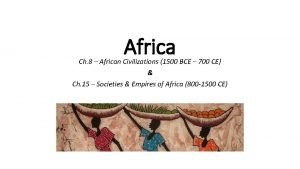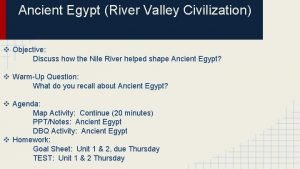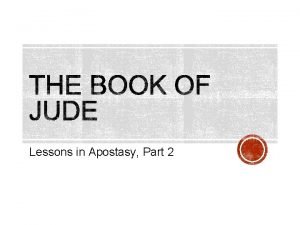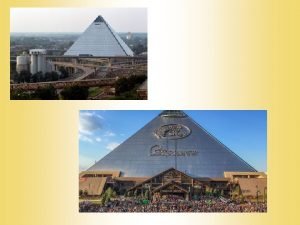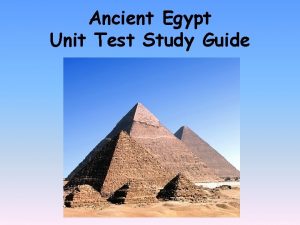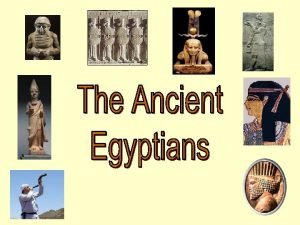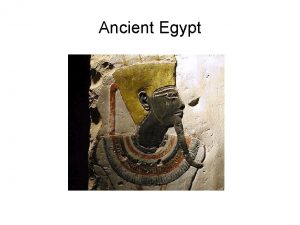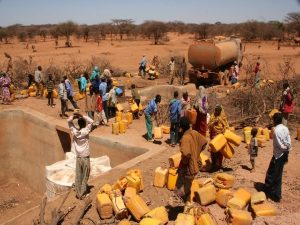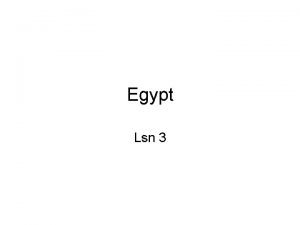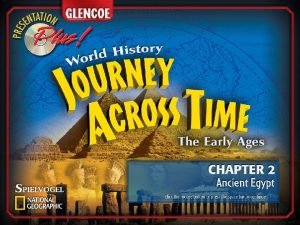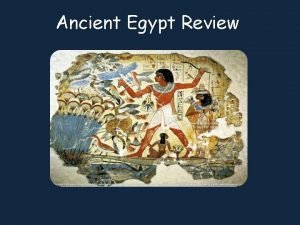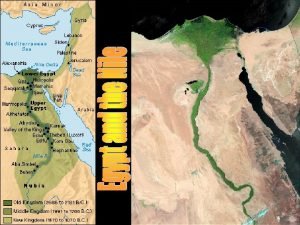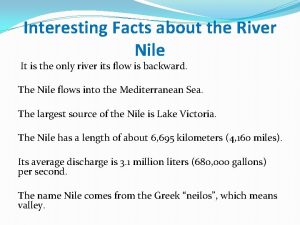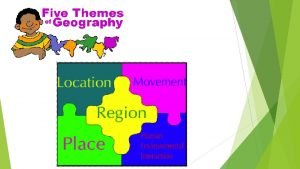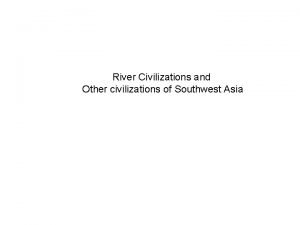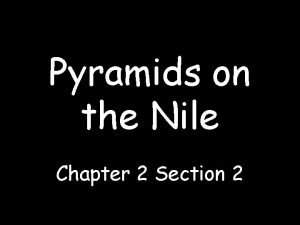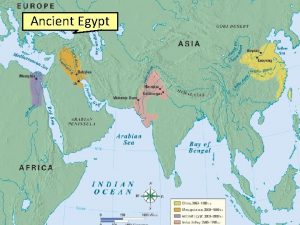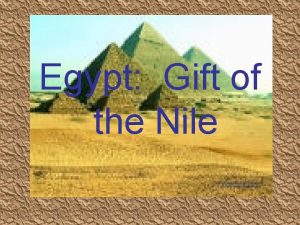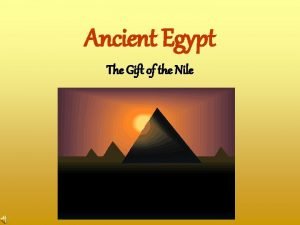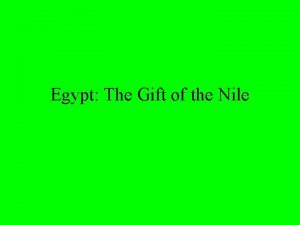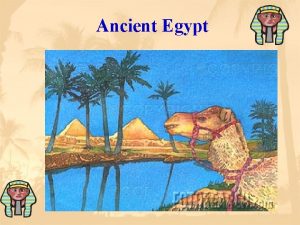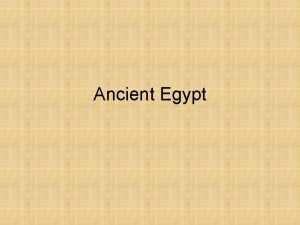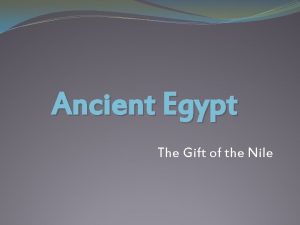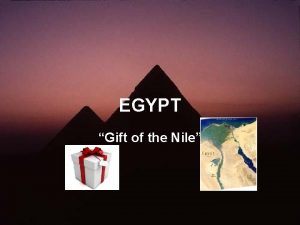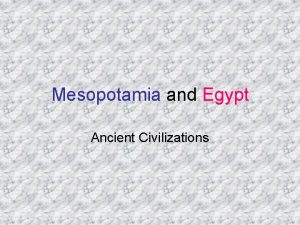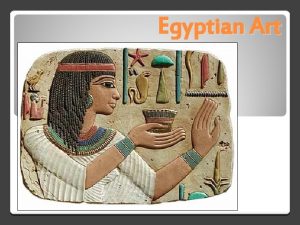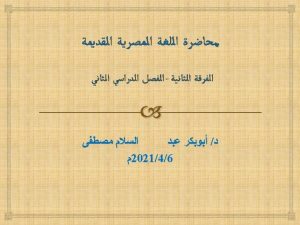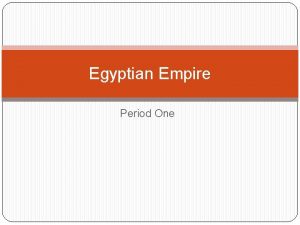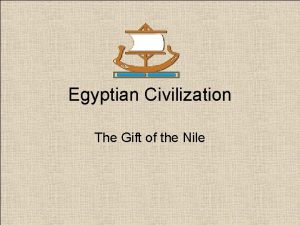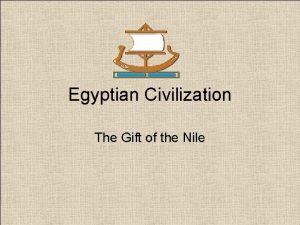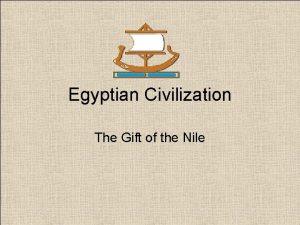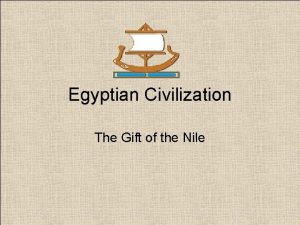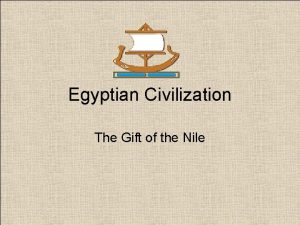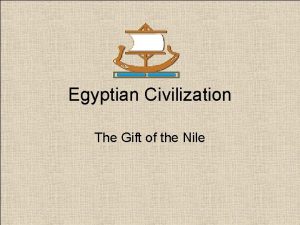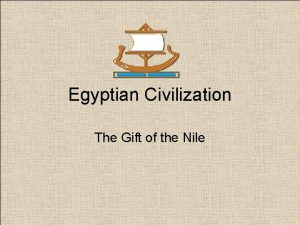EGYPT THE GIFT OF THE NILE Geography Egyptian

































- Slides: 33

EGYPT THE GIFT OF THE NILE


Geography • Egyptian civilization emerged in the Nile River Valley • The Nile is the longest river in the world, 4, 000 miles long • The Nile flows from Lake Victoria, located in east central Africa, northward to the Mediterranean Sea

• Three main regions of Egypt: – Upper Egypt – Lower Egypt – Nile Delta • The richest and most fertile soil found anywhere in Africa is found in the Nile Delta – Delta = a triangular region formed at the mouth of a river by deposits of silt • Water from the Nile was used for: – Irrigation (farming), drinking, bathing, transportation • Yearly flooding left silt which made rich soil and was controlled by dams


• Known as the Bread Basket of the Mediterranean • Egypt also had natural barriers that gave protection from invaders and a sense of security – Deserts to the east and west (especially the Sahara) – Red Sea to the east – Mediterranean Sea to the north – Cataracts on the southern part of the Nile

History • Egyptian history is divided into three major periods which are characterized by long-term prosperity and strong leadership – Old Kingdom – Middle Kingdom – New Kingdom • Between these periods were times of chaos and invasion known as Intermediate periods

Old Kingdom 2700 - 2200 BC • Powerful rulers took the title of pharaoh • Kingship was a divine institution and pharaohs had absolute power – Belief that the pharaoh was a god in human form – Egypt was a theocracy, a state ruled by a religious figure • Surrounded by a well-established bureaucracy – Bureaucracy = a highly structured organization, often governmental, managed by officials

• Pyramids were first built during the Old Kingdom – Pyramids were tombs for dead pharaohs • The Great Pyramid was constructed at Giza by King Khufu – Took 100, 000 Egyptians 20 years to build it – The Great Sphinx guards the Great Pyramid • Most pharaohs started building their pyramid as soon as they began their rule • Workers built the pyramids from the inside out • Most of the workers were peasants, not slaves, who were required to work for the gov’t one month out of the year



Intermediate Period • Period of chaos that lasted a 150 years • Powerful nobles began to assert their own authority as rivals of the pharaoh – The Old Kingdom finally collapsed – Time of famine, invasions, and civil wars

Middle Kingdom 2050 – 1650 BC • Period of conquest – Conquered Nubia as far south as the second cataract – Fortresses were built along the border of the Nile • New concern of the pharaohs for the people

Intermediate • Around 1650 raiders from Syria called Hyksos invaded the Nile Delta and conquered Lower Egypt

New Kingdom 1567 – 1085 BC • Decide to create an empire to keep foreign people from ever taking Egypt over again – Create an empire and becomes the most powerful state in Southwest Asia More wealth = impressive new temples


FAMOUS PHARAOHS • Hatshepsut – Proclaimed herself as pharaoh, the first woman to do so – She dressed like a man and wore a false beard • All statues of her made her out to be a man


• Amenhotep IV – Took the name Akhenaten – Tried to make Egyptians monotheistic by only worshipping one god, Aten the sun god – Banned the worship of all other gods and goddesses • Tutankhamon – Son of Amenhotep, restored the worship of Egypt’s traditional gods • Ramses II the Great – Great military leader, ruled for 60 years and brought much wealth to Egypt – Most admired pharaoh


Religion • Egyptians were polytheistic, had many important gods and goddesses – Key god was the god of the sun = Re or Amon-Re (Father of the pharaohs) • Believed that gods controlled all natural events • Priests performed rituals to fulfill the needs of the gods – Believed that the rituals refreshed the gods and kept them alive – In return the gods would grant the pharaohs immortality and bring prosperity to Egypt


Mummification • Central belief of the Egyptians was a belief in the afterlife • Practice of mummification = slowly drying a dead body to preserve it and stop it from rotting • Discovered after early Egyptians buried their dead in the desert, found that the bodies were being preserved, unfortunately jackals were eating the dead bodies

• Steps of mummification – Remove all internal organs – Brain was liquefied and drawn out the nose – The heart was left inside – controlled emotions and intelligence – Organs were placed in canopic jars to be buried with the mummy – Body was packed with various materials to help keep its shape – Salts were placed on the body to dry it out – Finally the body was wrapped in strips of linen


• Dead Egyptians were buried with their material possessions and sometimes loved ones or pets and servants • Rooms were stocked with supplies and material goods for the return of the ka – Also believed that people in paintings on the wall would come to life as well



Advancements • Main writing system was hieroglyphics – Used picture symbols to represent objects, sounds, and ideas – Carved into stone and written on papyrus – Developed in 3200 BC, considered one of the world’s first writing systems • Only Sumerian cuneiform is older • In 1799 a French soldier found a granite slab, now called the Rosetta Stone, which enabled historians to read hieroglyphics


• Math – Used math to build monuments and could calculate volume and area • Developed an accurate 365 day calendar


 Egypt is the gift of the nile
Egypt is the gift of the nile Aksum had access to the red sea blue nile and white nile
Aksum had access to the red sea blue nile and white nile How did the nile shape ancient egypt essay
How did the nile shape ancient egypt essay How did the nile shape ancient egypt dbq answer key
How did the nile shape ancient egypt dbq answer key History of floral design vocabulary
History of floral design vocabulary Hemiunu
Hemiunu 12 plagues of egypt
12 plagues of egypt Upper egypt and lower egypt
Upper egypt and lower egypt How did geography affect egypt's economy
How did geography affect egypt's economy Ancient egypt civilization geography
Ancient egypt civilization geography Nubia
Nubia Kush nile river
Kush nile river Janapriya nile valley madinaguda
Janapriya nile valley madinaguda Nile river
Nile river Goddess hapi
Goddess hapi University of northampton library
University of northampton library Nile river basin
Nile river basin Guided reading activity 2-1 the nile valley answer key
Guided reading activity 2-1 the nile valley answer key Nile
Nile River nile is called the lifeline of
River nile is called the lifeline of Nile floodplain
Nile floodplain Why was the nile so important
Why was the nile so important Hemorosis
Hemorosis Absolute location
Absolute location Nile river
Nile river Nile floodplain
Nile floodplain Eli ghazel
Eli ghazel Nile chemicals
Nile chemicals Chapter 2 section 2 pyramids on the nile worksheet answers
Chapter 2 section 2 pyramids on the nile worksheet answers Blue nile founder
Blue nile founder Ancient egypt frontalism
Ancient egypt frontalism Nile river
Nile river A section of the nile river with rapids and rocky terrain
A section of the nile river with rapids and rocky terrain What model is it
What model is it

